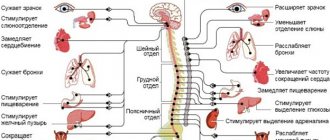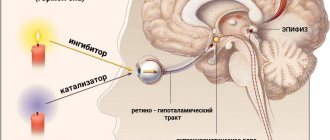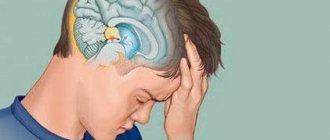The pineal gland (or pineal body, corpus pineale) is an endocrine gland. It is located deep in the brain and resembles a pine cone in appearance. This appearance is due to the rapid impulsive growth of the organ and the presence of a rich network of capillaries around it. The role of the pineal gland is still not fully understood.
It is known that the pineal gland produces the following hormones:
- Melatonin.
- Adrenoglomerulotropin.
- Serotonin.
- Histamine.
- Norepinephrine.
- Other peptide hormones.
Functions of pineal gland hormones
Melatonin
Melatonin is the main hormone synthesized by the pineal gland. Its main function is to regulate the body’s circadian rhythm (sleep-wake). This occurs due to the wave-like release of melatonin, with the peak concentration of this substance in the blood occurring between 1 and 5 am. Melatonin synthesis depends on the level of light: the less light, the more it is produced.
Apart from this, there are a number of other functions of melatonin:
- Decreased body activity (physical, mental, emotional).
- Pressure regulation.
- Reduced growth rate of the child.
- Regulation of seasonal processes in animals (migration, hibernation, molting, storage of substances for the winter).
- Increased activity of immune system cells.
- Reduced calcium intake from the blood into bone tissue.
- Reducing the rate of aging of the body.
- Antioxidant action.
This hormone actually has many actions, which determines its necessity for the normal functioning of the whole organism.
Adrenoglomerulotropin
Many authors do not distinguish adrenoglomerulotropin as an independent hormone, since in fact it is melatonin, which has undergone a number of chemical changes. However, for the sake of completeness, let’s consider his role. Adrenoglomerulotropin increases the release of aldosterone in the glomeruli of the adrenal cortex. Due to the action of aldosterone, water retention in the body occurs, the loss of sodium and chlorine ions decreases, and the release of potassium and hydrogen increases. As a result, there is an increase in circulating blood volume and an increase in blood pressure.
Serotonin
Serotonin has a dual role in the body.
On the one hand, it acts as a neurotransmitter, ensuring rapid transmission of impulses in some parts of the nervous system (brain stem, spinal cord, cerebellum, limbic system). This determines the participation of serotonin in such important areas of activity as spatial orientation, emotional state, the functioning of basic reflexes and the maintenance of vital functions (control of blood pressure, heart rate, respiratory rate).
On the other hand, due to the release of serotonin into the blood, it can act as a hormone, acting on target organs. Its effects in this ampoule will be as follows:
- Increased secretion of substance P (indirect effect on blood pressure, enhanced action of immune cells, activation of digestive processes).
- Regulation of vascular lumen.
- Stimulation of prolactin secretion (indirect effect on increasing milk production in the mammary glands).
- Increased blood clotting.
- Stimulation of digestive processes.
- Increase in pleasant, positive emotions (“happiness hormone”).
Just like the formation of melatonin, the synthesis of serotonin requires sunlight.
Histamine
Histamine can be released in different places in the body: it is formed in the pineal gland, contained in mast cells (histiocytes), which are found in almost all parts of the body (intestines, bronchi, lungs, skin).
This hormone has quite a lot of actions, we will try to list the main ones:
- Reduction of bronchial lumen.
- Reducing the diameter of blood vessels.
- Stimulation of the pituitary gland (indirect effect on the release of tropic hormones (ACTH, TSH, STH, LTG), vasopressin, oxytocin).
- Increased formation of gastric juice.
- Increased release of certain nervous system mediators (GABA, acetylcholine, norepinephrine, serotonin).
- Increased blood pressure and heart rate.
It is worth noting that one of the main meanings of histamine is its participation in allergic reactions. That is why many of its effects help remove foreign elements (allergens) from the body.
Norepinephrine
Norepinephrine is one of the main mediators of the sympathetic nervous system. Due to this, it has the following effects:
- Reducing the lumen of blood vessels.
- Increased frequency and strength of heart contractions.
- Increased blood pressure.
- Promotes the release of glucose from tissues into the blood.
- Increases the lumen of the bronchi.
In addition, adrenaline stimulates the transmission of nerve impulses to the central nervous system, resulting in an improvement in cognitive functions (thinking, memory, reaction speed).
Conclusion
The secretion of all pineal gland hormones depends on many factors, the main one of which is the level of light. In addition, physical activity, the quality and quantity of food consumed, and the use of medications are important.
Also, all hormones of the pineal gland are modified amino acids in their structure, so for their synthesis it is necessary to satisfy the body's need for protein foods.
For convenience, below is a table of the main hormones of the pineal gland and their functions.
The main hormones of the pineal gland and their functions
| Hormone | Function |
| Melatonin |
|
| Adrenoglomerulotropin |
|
| Serotonin |
|
| Histamine |
|
| Norepinephrine |
|
Treatment
You need to be treated under the supervision of an endocrinologist. According to the ICD (international classification of diseases), serious pathologies of the pineal gland are relatively rare. Most often, it is not treatment of the gland that is required, but correction of the daily routine, nutrition, and lifestyle.
Therapeutic tactics will depend on the specific reason that caused the changes. Therapy is mainly aimed at eliminating emerging symptoms and compression. Melaxen may be prescribed among medications.
Most often, the use of medications eliminates only part of the symptoms, but does not in any way affect the disease itself. Medicines are effective in the early stages of development of hydatid cysts. If there is no obvious improvement, the signs have not gone away, critical growth or a pronounced deviation of the gland to the side is observed, it will be necessary to resort to surgery. During this procedure, craniotomy is performed and the tumor is removed.
Surgical therapy should be treated as the only way to restore health and a high quality of life. Despite all the risks, such intervention is justified. The cyst or tumor must be removed, so the help of a neurosurgeon will be required. If the operation is successful, the prognosis is optimistic - negative symptoms will no longer appear, and the body will fully recover.
Direct indications for surgery:
- obvious symptoms that seriously harm health;
- the tumor affects other areas of the brain;
- there is a risk that hydrocephalus will develop;
- the cardiovascular system suffers;
There must be very good reasons for carrying out the operation. Surgical removal is indicated when the formation has become dangerous, is growing rapidly, or hyperfunction of the gland is observed. It can activate serious hormonal imbalances, leading to problems with internal organs and dystonia. Women with a malfunction of the pineal gland may have problems conceiving and bearing a child. To accurately establish the diagnosis, in addition to MRI, CT, ultrasound, a blood test may be prescribed.
If there is no severe pathology, infection, or the disease does not progress, sometimes it is enough to establish the process of melatonin production so that the body returns to normal and life brings pleasure again.
The therapeutic effect is provided not only by medications, but also by proper planning of the regimen.
It is important for such patients to strictly adhere to the daily routine, live according to a schedule, get enough sleep, and completely turn off the lights at night. They are strictly contraindicated from working in the dark. You should also avoid stress and outbursts of emotions, even positive ones. It is useful to engage in debate and walk in the fresh air.
If you have pathologies of the pineal gland, you should not waste time on folk remedies. They are ineffective. It is important for the patient to be under the supervision of an endocrinologist from the early stages of the disease, since the functions of the thyroid gland may suffer.
The pineal gland has been little studied, because its activities are surrounded by myths and an aura of mystery. Mystics believe that the soul lives in it, and esotericists call it nothing more than the “third eye.” It is believed that it has an impact on the spiritual sphere and carries an astral code. There is an opinion that by developing it, one can achieve extrasensory abilities. For these purposes, it is even recommended to stimulate the pineal gland with music, light, and take lessons to master esoteric techniques.
Conclusion
Remember that health is a gift that can be easily lost! In order for the pineal gland to cope with its assigned functions, you should strictly monitor your daily routine, diet, get enough sleep, and lead a healthy active lifestyle.
You shouldn’t change your habits suddenly; the main thing is to gradually bring them back to normal. These are excellent preventive measures that will prevent pathological changes in this mysterious gland, which is responsible not only for physiology, but also for intelligence.
The role of the pineal gland in the body
The pineal gland is located between the cerebral hemispheres above the superior colliculus of the midbrain.
In the medical literature there are also such names for this endocrine gland - pineal gland, penial gland.
The role of the pineal gland in the body is to ensure the most important biological processes:
- regulation of sleep and wakefulness;
- influence on the pituitary gland and inhibition of growth hormone secretion;
- inhibition of puberty;
- strengthening the immune system;
- antioxidant effect;
- antitumor protection;
- the ability to slow down the aging process.
How to effectively support the pineal gland?
First of all, you should maintain a normal daily routine. You need to fall asleep around 11 pm and sleep in the dark. Scientific research has shown that if sleep occurs in the light, then the brain receives an appropriate signal. As a result, the pineal gland believes that it is still day outside with all the ensuing negative consequences.
The study of this theory began in the city of Ivanovo. Scientists have recorded a sharp increase in the number of women who worked in a clothing factory and developed breast cancer. After conducting a set of studies, a connection was established between the health problems of female workers and working in 3 shifts in the workshop. Moreover, women who worked at night were three times more likely to develop cancer compared to seamstresses who worked during the day.
This trend suggests that normal melatonin synthesis reduces the risk of tumors. Plus, by maintaining normal levels of this hormone in adulthood, one can achieve a reduction in biological age.
In this case, a decrease in melatonin synthesis can cause:
- Cardiovascular diseases;
- Hypertension;
- Oncological diseases;
- Development of Alzheimer's and Parkinson's diseases;
- Sleep problems;
- The appearance of diabetes mellitus.
Melatonin begins to form at 6 months, when the baby becomes aware of the onset of day and night. By 12 months, the concentration of this hormone reaches its maximum in our entire life, which persists until approximately the age of ten. Melatonin levels decrease during puberty. As a result, by the age of 20, the optimal level of the hormone in question for our body is formed. Then gradually the concentration of melatonin decreases and by the age of eighty it is reduced to 0.
Factors influencing melatonin synthesis.
Increase : vitamins, reduced caloric intake.
Reduce : increased dosages of vitamins B12, caffeine, bad habits (cigarettes, alcohol), taking medications.
In the US you can find melatonin in tablets. But we recommend that you refrain from using it, since an excess of any hormone leads to the cessation of the production of your own. From this we can come to the conclusion that the best solution to the problem is to create conditions for the body to independently produce melatonin. The pineal peptide, Endoluten, copes well with this task.










